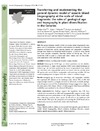Identificador persistente para citar o vincular este elemento:
https://accedacris.ulpgc.es/jspui/handle/10553/52562
| Título: | Transferring and implementing the general dynamic model of oceanic island biogeography at the scale of island fragments: The roles of geological age and topography in plant diversification in the Canaries | Autores/as: | Otto, Rüdiger Whittaker, Robert J. von Gaisberg, Markus Stierstorfer, Christian Naranjo-Cigala, Agustin Steinbauer, Manuel J. Borregaard, Michael K. Arévalo, José Ramón Garzón-Machado, Víctor del Arco, Marcelino Fernández-Palacios, José María |
Clasificación UNESCO: | 250501-1 Biogeografía botánica | Palabras clave: | Canary Islands Endemic plants Environmental heterogeneity General dynamic model Island biogeography, et al. |
Fecha de publicación: | 2016 | Publicación seriada: | Journal of Biogeography | Resumen: | Aim: The general dynamic model (GDM) of oceanic island biogeography integrates rates of immigration, speciation and extinction in relation to a humped trajectory of island area, species carrying capacity and topographic complexity through time, based on a simplified island ontogeny. In practice, many islands have more complex ontogenies, featuring surfaces of varying age. Here, we extend the GDM to apply at a local scale within islands, and test the predictions analytically within individual islands. Location: El Hierro, La Palma and Tenerife (Canary Islands). Methods: Following the GDM logic, we derive predictions for the distributions and richness of single island endemics (SIEs) across island landscapes of different age. We test these predictions by means of generalized linear models and binominal tests using gridded species occurrence data for vascular plant SIE species and a set of climatic, topographic and terrain age variables. We also examined phylogenetic divergence times for a subset of endemic lineages. Results: Geological age, in interaction with slope, and topographic variables, best explained SIE richness at the landscape scale. About 70% of SIEs had ranges strongly biased to, or largely restricted to old terrain. Available phylogenetic divergence times of SIEs of radiated plant lineages suggested an origin on the older parts of the islands. Metrics of anthropogenic disturbance and habitat availability were unrelated to the observed SIE pattern. Main conclusions: Our findings support the hypothesis that SIEs have evolved and accumulated on older and topographically complex terrain, while colonization processes predominate on the youngest parts. These results imply that evolutionary processes shape species distributions at the landscape scale within islands. This opens the perspective of extending the GDM framework to understand processes at a local scale within individual islands. | URI: | https://accedacris.ulpgc.es/handle/10553/52562 | ISSN: | 0305-0270 | DOI: | 10.1111/jbi.12684 | Fuente: | Journal Of Biogeography[ISSN 0305-0270],v. 43 (5), p. 911-922 |
| Colección: | Artículos |
Citas SCOPUSTM
22
actualizado el 08-jun-2025
Citas de WEB OF SCIENCETM
Citations
17
actualizado el 08-jun-2025
Visitas
127
actualizado el 14-dic-2024
Descargas
190
actualizado el 14-dic-2024
Google ScholarTM
Verifica
Altmetric
Comparte
Exporta metadatos
Los elementos en ULPGC accedaCRIS están protegidos por derechos de autor con todos los derechos reservados, a menos que se indique lo contrario.
